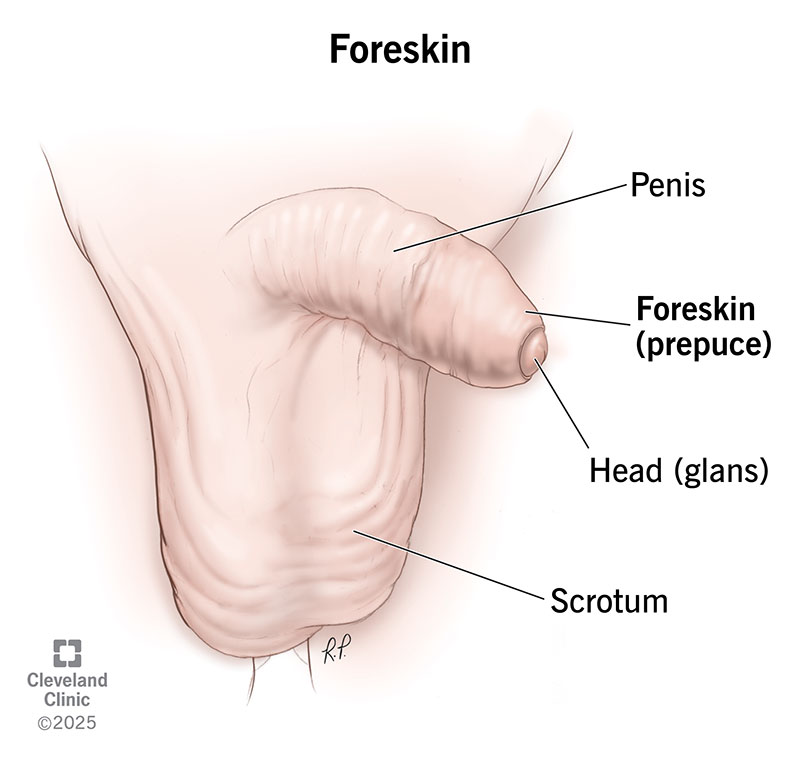Foreskin is a moveable layer of skin that covers the head of your penis. It helps protect your penis and aids in sexual pleasure. But it may also increase your chances of getting some conditions. It’s tight to the penis through early childhood. As you age, it loosens so you can retract it. Proper care is important to prevent infections and other conditions.
Advertisement
Cleveland Clinic is a non-profit academic medical center. Advertising on our site helps support our mission. We do not endorse non-Cleveland Clinic products or services. Policy

Foreskin is an outer layer of skin that covers the head of your penis (glans) and the opening at the tip (meatus). In infancy and early childhood, the foreskin is tight — you can’t pull it back (retract) over the head of the penis. But as you age, the foreskin usually loosens. This allows you to comfortably retract it over the glans.
Advertisement
Cleveland Clinic is a non-profit academic medical center. Advertising on our site helps support our mission. We do not endorse non-Cleveland Clinic products or services. Policy
Another name for foreskin is prepuce (PREE-pyoos).
The purpose of foreskin has been a subject of debate. Some researchers believe that it protects your penis from friction. They also think it helps increase sexual pleasure. Increased sexual pleasure may help in reproduction. Others believe that foreskin may increase your chance of getting certain diseases.
These conflicting views often come up in debates about circumcision. A circumcision is the removal of foreskin. It usually happens during the first few days after a male baby’s birth. But adults can get it, too. Some groups consider circumcision a religious rite. Others consider it a helpful medical procedure.
Foreskin is at the tip of your penis. In newborns and young children, the foreskin is tight to the tip of the penis. You shouldn’t be able to pull it back. As you age — usually around 5 years old — it separates from the glans and becomes retractable. This allows you to pull it back so you can clean the head of your penis.
Foreskin consists of a fold of mucosal tissue on the inside and keratinized skin. The mucosal tissue has a lot of sensitive nerve endings. Keratin is a protein that helps provide strength and flexibility in your skin. It also helps protect it from water. When you’re flaccid (not erect), it looks like a loose layer of extra skin with an opening at the tip. When you have an erection, it usually retracts on its own to reveal the head of your penis. But you may need to roll it back yourself.
Advertisement
Foreskin is usually a bit darker than the rest of your skin.
The average length of foreskin is about 2.5 inches (6.4 centimeters). But it can range from a little less than 2 inches to about 3.5 inches (4.8 to 9.2 centimeters).
Common conditions that affect your foreskin may also affect your entire penis. Some include:
It’s a good idea to reach out to a healthcare provider if you have any of the following signs or symptoms of disease:
Nearly all newborn males have tight foreskins at birth that usually loosen as they get older.
Infections, inflammation, scarring and trauma (like using too much force to pull your foreskin back) can cause the foreskin to tighten.
There are some tips to make sure that you and your genitals, including your foreskin, stay healthy. You probably know about the usual recommendations like eating plenty of fruits and veggies, drinking lots of water, getting physical activity and not smoking. But tips that are more specific to your foreskin include:
Advertisement
Yes, once your foreskin naturally separates from the tip of your penis. Gently pull it back when you bathe, and be sure to gently pat it dry. It’s also important to pull your foreskin back to expose the meatus when you use the bathroom. This helps prevent pee from gathering under your foreskin, which can cause irritation or an infection.
Help your child pull their foreskin back around the time they start potty training. Try to retract it each time they use the bathroom and when they bathe.
There are cultural and religious reasons to circumcise your child. Some people decide to do it because it’s easier to take care of, or they think it looks better. There are also some health benefits, including reduced risks of STIs, UTIs, phimosis and penile cancer. In adults with severe cases of phimosis or paraphimosis, they may need a circumcision to prevent penile tissue death (necrosis).
It’s not “good” or “bad” to remove your foreskin. It’s a parental decision. If you have any questions, talk to your child’s healthcare provider. They can go over the pros and cons to help you make a more informed choice.
If you never had a circumcision, you have a foreskin. It’s a layer of skin that covers the head of your penis. Keeping it clean is important. That helps prevent some conditions that can occur with foreskin, like infections. If you have pain, itching or any other symptoms that concern you, talk to a healthcare provider. They can make a diagnosis, if necessary, and explain how to care for your foreskin.
Advertisement
When something’s wrong with your penis, you’ll want to get care right away. Cleveland Clinic’s experienced urology providers are here for you.

Last reviewed on 08/04/2025.
Learn more about the Health Library and our editorial process.